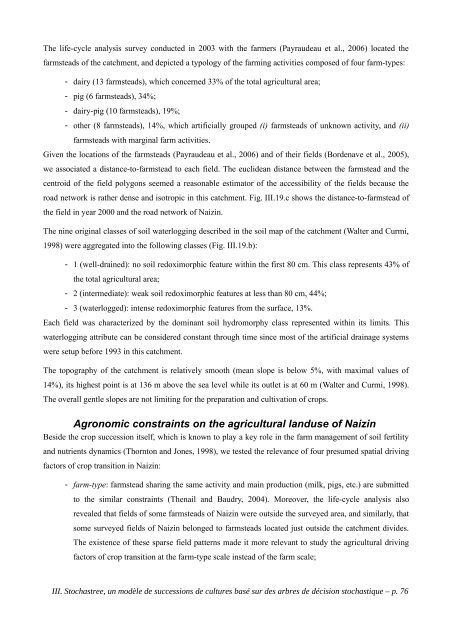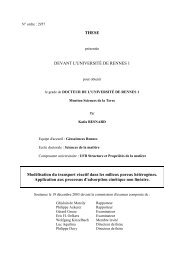Paysages virtuels et analyse de scénarios pour évaluer les impacts ...
Paysages virtuels et analyse de scénarios pour évaluer les impacts ...
Paysages virtuels et analyse de scénarios pour évaluer les impacts ...
You also want an ePaper? Increase the reach of your titles
YUMPU automatically turns print PDFs into web optimized ePapers that Google loves.
The life-cycle analysis survey conducted in 2003 with the farmers (Payrau<strong>de</strong>au <strong>et</strong> al., 2006) located the<br />
farmsteads of the catchment, and <strong>de</strong>picted a typology of the farming activities composed of four farm-types:<br />
- dairy (13 farmsteads), which concerned 33% of the total agricultural area;<br />
- pig (6 farmsteads), 34%;<br />
- dairy-pig (10 farmsteads), 19%;<br />
- other (8 farmsteads), 14%, which artificially grouped (i) farmsteads of unknown activity, and (ii)<br />
farmsteads with marginal farm activities.<br />
Given the locations of the farmsteads (Payrau<strong>de</strong>au <strong>et</strong> al., 2006) and of their fields (Bor<strong>de</strong>nave <strong>et</strong> al., 2005),<br />
we associated a distance-to-farmstead to each field. The eucli<strong>de</strong>an distance b<strong>et</strong>ween the farmstead and the<br />
centroid of the field polygons seemed a reasonable estimator of the accessibility of the fields because the<br />
road n<strong>et</strong>work is rather <strong>de</strong>nse and isotropic in this catchment. Fig. III.19.c shows the distance-to-farmstead of<br />
the field in year 2000 and the road n<strong>et</strong>work of Naizin.<br />
The nine original classes of soil waterlogging <strong>de</strong>scribed in the soil map of the catchment (Walter and Curmi,<br />
1998) were aggregated into the following classes (Fig. III.19.b):<br />
- 1 (well-drained): no soil redoximorphic feature within the first 80 cm. This class represents 43% of<br />
the total agricultural area;<br />
- 2 (intermediate): weak soil redoximorphic features at <strong>les</strong>s than 80 cm, 44%;<br />
- 3 (waterlogged): intense redoximorphic features from the surface, 13%.<br />
Each field was characterized by the dominant soil hydromorphy class represented within its limits. This<br />
waterlogging attribute can be consi<strong>de</strong>red constant through time since most of the artificial drainage systems<br />
were s<strong>et</strong>up before 1993 in this catchment.<br />
The topography of the catchment is relatively smooth (mean slope is below 5%, with maximal values of<br />
14%), its highest point is at 136 m above the sea level while its outl<strong>et</strong> is at 60 m (Walter and Curmi, 1998).<br />
The overall gentle slopes are not limiting for the preparation and cultivation of crops.<br />
Agronomic constraints on the agricultural landuse of Naizin<br />
Besi<strong>de</strong> the crop succession itself, which is known to play a key role in the farm management of soil fertility<br />
and nutrients dynamics (Thornton and Jones, 1998), we tested the relevance of four presumed spatial driving<br />
factors of crop transition in Naizin:<br />
- farm-type: farmstead sharing the same activity and main production (milk, pigs, <strong>et</strong>c.) are submitted<br />
to the similar constraints (Thenail and Baudry, 2004). Moreover, the life-cycle analysis also<br />
revealed that fields of some farmsteads of Naizin were outsi<strong>de</strong> the surveyed area, and similarly, that<br />
some surveyed fields of Naizin belonged to farmsteads located just outsi<strong>de</strong> the catchment divi<strong>de</strong>s.<br />
The existence of these sparse field patterns ma<strong>de</strong> it more relevant to study the agricultural driving<br />
factors of crop transition at the farm-type scale instead of the farm scale;<br />
III. Stochastree, un modèle <strong>de</strong> successions <strong>de</strong> cultures basé sur <strong>de</strong>s arbres <strong>de</strong> décision stochastique – p. 76



